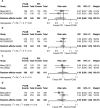A comparison of efficacy and safety of potassium-competitive acid blocker and proton pump inhibitor in gastric acid-related diseases: A systematic review and meta-analysis
- PMID: 36181401
- PMCID: PMC10092067
- DOI: 10.1111/jgh.16017
A comparison of efficacy and safety of potassium-competitive acid blocker and proton pump inhibitor in gastric acid-related diseases: A systematic review and meta-analysis
Abstract
Background and aim: Potassium-competitive acid blocker (PCAB) is a recent alternative to proton pump inhibitor (PPI) for potent acid suppression. The current systematic review and meta-analysis aimed to compare the efficacy and safety of PCAB versus PPI in treating gastric acid-related diseases.
Methods: We searched up to June 5, 2022, for randomized controlled trials of gastric acid-related diseases that included erosive esophagitis, symptomatic gastroesophageal reflux disease (GERD), peptic ulcers, and Helicobacter pylori infection. The pooled risk ratio (RR) was evaluated for the efficacy outcome and treatment-emergent adverse events (TEAEs) as the safety outcome. Sensitivity analyses were performed to test the robustness of the study findings.
Results: Of the 710 screened studies, 19 studies including 7023 participants were analyzed. The RRs for the healing of erosive esophagitis with Vonoprazan versus PPI were 1.09 (95% confidence interval [CI] 1.03-1.14), 1.03 (95% CI 1.00-1.07), and 1.02 (95% CI 1.00-1.05) in Weeks 2, 4, and 8, respectively. There were no differences in the improvement of GERD symptoms and healing of gastric and duodenal ulcers between PCAB and PPI. The pooled eradication rates of H. pylori were significantly higher in Vonoprazan versus PPI first-line treatment (RR 1.13; 95% CI 1.04-1.22). The overall RR of TEAEs with Vonoprazan versus PPI was 1.08 (95% CI 0.89-1.31). Overall, the risk of bias was low to some concerns. Furthermore, sensitivity analyses confirmed the robustness of the study's conclusion.
Conclusion: Vonoprazan is superior to PPI in first-line H. pylori eradication and erosive esophagitis but non-inferior in other gastric acid-related diseases. Likewise, short-term safety is comparable in both treatment groups.
Keywords: gastric acid-related diseases; meta-analysis; potassium-competitive acid blocker; proton pump inhibitor; vonoprazan.
© 2022 The Authors. Journal of Gastroenterology and Hepatology published by Journal of Gastroenterology and Hepatology Foundation and John Wiley & Sons Australia, Ltd.
Figures


 ) Vonoprazan (PCAB) and (
) Vonoprazan (PCAB) and ( ) PPI. The healing rate and eradication rate are presented in % with its 95% confidence interval. PCAB, potassium‐competitive acid blocker; PPI, proton pump inhibitor.
) PPI. The healing rate and eradication rate are presented in % with its 95% confidence interval. PCAB, potassium‐competitive acid blocker; PPI, proton pump inhibitor.



References
-
- Kusano M, Kuribayashi S, Kawamura O et al. A review of the management of gastric acid‐related diseases: focus on rabeprazole. Clin Med Gastroenterol. 2011; 4: CGast.S5133.
-
- Peura DA, Gudmundson J, Siepman N, Pilmer BL, Freston J. Proton pump inhibitors: effective first‐line treatment for management of dyspepsia. Dig. Dis. Sci. 2007; 52: 983–987. - PubMed
-
- Sachs G, Shin JM, Munson K, Scott DR. Gastric acid‐dependent diseases: a twentieth‐century revolution. Dig. Dis. Sci. 2014; 59: 1358–1369. - PubMed
Publication types
MeSH terms
Substances
Grants and funding
LinkOut - more resources
Full Text Sources
Medical

